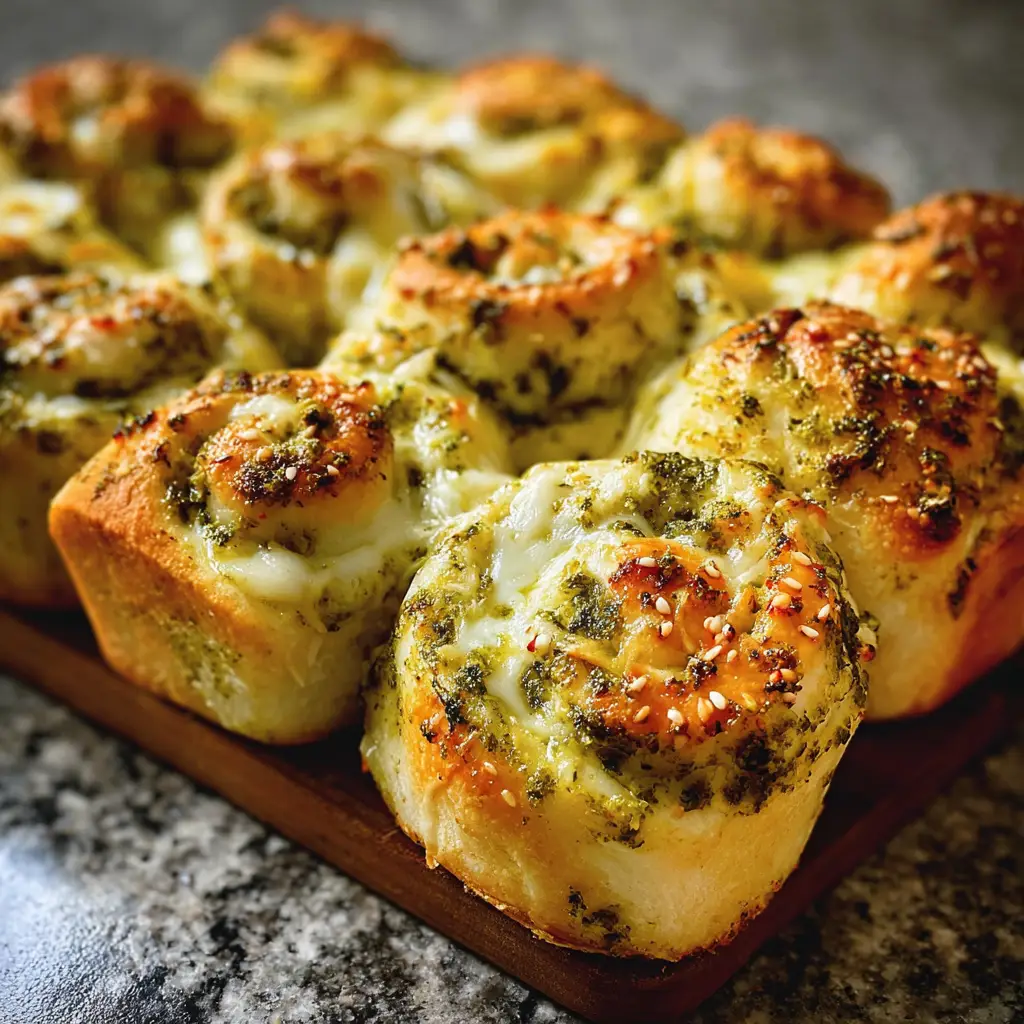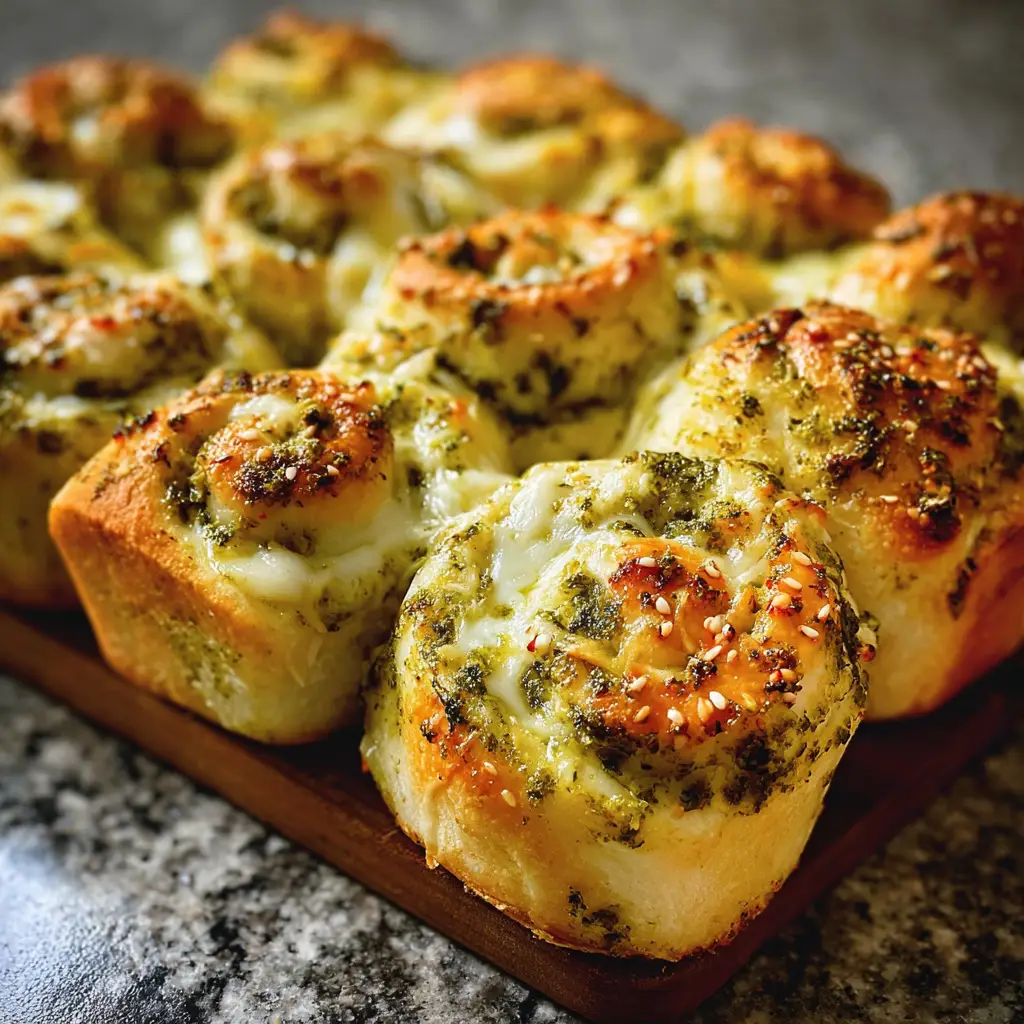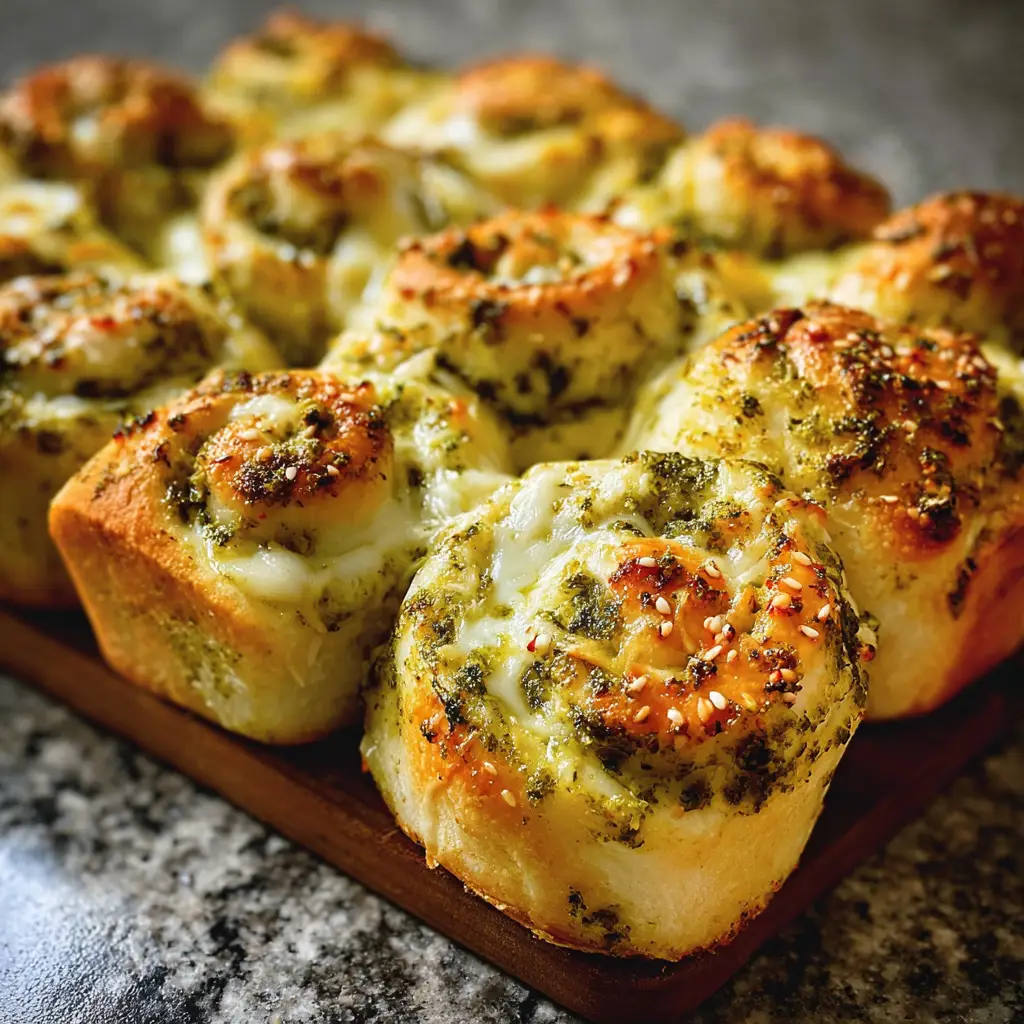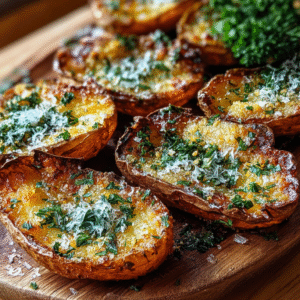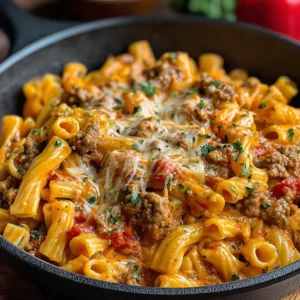| Prep Time: 20 minutes | Cook Time: 25 minutes | Total Time: 2 hours 45 minutes | Serves: 12 |
|---|
Why Cheesy Pesto Bread Rolls Deserve Center Stage
The magic of cheesy pesto bread rolls lies in their ability to transform simple ingredients into complex flavor experiences that satisfy both comfort food cravings and gourmet expectations because the aromatic basil pesto penetrates every fiber of the tender bread while the melted cheese creates pockets of creamy richness that contrast beautifully with the herb-infused dough. Unlike store-bought dinner rolls that often taste bland and lack character, these homemade treasures deliver layers of flavor that develop and intensify with each bite because the yeast fermentation process enhances the basil and garlic notes while creating the perfect texture foundation for the cheese and pesto filling.
The visual appeal of these rolls cannot be overstated because their golden-brown exteriors, vibrant green pesto swirls, and melted cheese create an Instagram-worthy presentation that generates excitement even before anyone takes their first bite. The contrast between the rustic, homemade appearance and the sophisticated flavor profile makes these rolls perfect for both casual family dinners and elegant entertaining because they demonstrate culinary skill while remaining approachably delicious for guests of all ages and taste preferences.
What makes these rolls particularly special is their versatility because they function equally well as appetizers, side dishes, or even light meals when paired with a fresh salad, and their make-ahead friendly nature allows busy home cooks to prepare them in advance without sacrificing quality or flavor impact. The combination of herbs, cheese, and bread appeals to multiple cultural backgrounds while maintaining a distinctly Italian inspiration that feels both familiar and exciting.
Essential Ingredients for Perfect Cheesy Pesto Bread Rolls
Creating exceptional cheesy pesto bread rolls requires carefully selected ingredients that work harmoniously to deliver the perfect balance of flavor, texture, and visual appeal because each component plays a crucial role in the final result that will grace your table.
Bread Flour – 3 cups of high-quality bread flour provides the essential protein structure that creates the perfect chewy yet tender texture because the higher gluten content develops better elasticity and creates the ideal foundation for holding the pesto and cheese filling without becoming soggy or dense.
Instant Yeast – 1 packet (2¼ teaspoons) of instant yeast ensures reliable rising and develops the complex flavors that only yeast fermentation can provide because this living ingredient transforms simple flour and water into aromatic, flavorful bread while creating the light, airy texture that makes each bite so satisfying.
Warm Water – 1 cup of lukewarm water activates the yeast and hydrates the flour because the precise temperature creates optimal conditions for yeast activity while contributing to the final texture and helping all ingredients blend seamlessly into smooth, workable dough.
Extra Virgin Olive Oil – 3 tablespoons of premium olive oil enriches the dough with subtle fruity flavors while creating tenderness and extending the shelf life because quality oil contributes to both taste and texture while complementing the Italian flavor profile of the pesto filling.
Fresh Basil Pesto – ½ cup of vibrant basil pesto forms the flavor heart of these rolls because this aromatic blend of fresh basil, garlic, pine nuts, Parmesan cheese, and olive oil infuses every bite with authentic Italian taste that transforms ordinary bread into something extraordinary.
Mozzarella Cheese – 1½ cups of freshly shredded mozzarella provides the creamy, melted cheese element that creates irresistible stretchy pulls and rich dairy flavor because this mild cheese complements rather than competes with the bold pesto while delivering the comfort food satisfaction that makes these rolls so appealing.
Parmesan Cheese – ½ cup of freshly grated Parmesan adds sharp, nutty depth that enhances the overall flavor complexity because this aged cheese provides the umami element that elevates the entire taste experience while creating beautiful golden-brown spots when it melts and caramelizes.
Sea Salt – 1 teaspoon of fine sea salt enhances all the other flavors while strengthening the gluten structure because proper seasoning is essential for bread making and brings out the best in both the dough and the filling ingredients.
Granulated Sugar – 1 tablespoon of sugar feeds the yeast and contributes to browning because this small amount helps achieve the perfect golden color while ensuring vigorous yeast activity that creates optimal rise and texture.
Unsalted Butter – 2 tablespoons of softened butter adds richness and creates a tender crumb because this dairy fat contributes to both flavor and texture while helping create the perfect eating experience.
The Art of Creating Perfect Cheesy Pesto Bread Rolls
Mastering the creation of cheesy pesto bread rolls requires understanding the delicate interplay between yeast activity, gluten development, and flavor integration because successful bread making depends on timing, technique, and attention to detail that transforms simple ingredients into bakery-quality results.
The foundation of exceptional rolls begins with proper yeast handling because this living organism must be treated with respect and provided with optimal conditions to perform its magic of fermentation and leavening. Temperature control becomes crucial throughout the entire process because yeast is sensitive to extremes, and maintaining consistent warmth during mixing, rising, and baking ensures predictable results that meet your expectations every time you prepare these rolls.
Understanding gluten development helps you achieve the perfect texture because the protein networks that form during mixing and kneading create the structure that holds the pesto and cheese filling while maintaining the light, airy quality that makes these rolls so enjoyable to eat. The rising process allows flavors to develop and meld because fermentation creates complex taste compounds that elevate the final product beyond the sum of its individual ingredients.
Timing becomes an art form because each stage of preparation builds upon the previous steps, and rushing the process compromises both texture and flavor development that distinguish homemade bread from commercial alternatives. The visual cues that indicate proper dough development, adequate rising, and perfect doneness require practice to master, but understanding these signals ensures consistent success with every batch you create.Cheesy Pesto Bread Rolls
Step-by-Step Instructions for Cheesy Pesto Bread Roll Mastery
Follow these detailed instructions to create cheesy pesto bread rolls that will become a beloved family tradition because proper technique ensures consistent results that showcase the beautiful combination of flavors and textures that make these rolls so special.
Step 1: Prepare the Dough Foundation Begin by combining the warm water, sugar, and instant yeast in the bowl of your stand mixer, whisking gently to dissolve the sugar and distribute the yeast evenly because this initial mixture creates the perfect environment for yeast activation. Allow this mixture to rest for 5 minutes until it becomes foamy and fragrant, indicating that your yeast is active and ready to create the leavening power your rolls need. Add the olive oil, salt, and softened butter to the yeast mixture, whisking until everything is well combined because proper integration of fats and seasonings at this stage ensures even distribution throughout the finished dough.
Professional Tip: Test your water temperature with a thermometer to ensure it falls between 100-110°F because water that’s too hot will kill the yeast while water that’s too cool won’t activate it properly, and proper temperature control is crucial for successful bread making.
Key Points: The yeast mixture should smell pleasantly sweet and yeasty when properly activated, and you should see bubbles forming on the surface, indicating healthy yeast activity that will produce well-risen rolls.
Step 2: Mix and Knead the Dough Add the bread flour to your wet ingredients in two stages, mixing with the dough hook on low speed until the flour is just incorporated before adding the remaining flour because gradual incorporation prevents lumps and creates smoother dough development. Increase the mixer speed to medium and knead for 8-10 minutes until the dough becomes smooth, elastic, and pulls away from the sides of the bowl because proper gluten development is essential for creating the structure that will hold your pesto and cheese filling without becoming heavy or dense.
Professional Tip: The windowpane test helps determine proper gluten development by stretching a small piece of dough until it becomes thin enough to see light through without tearing because this indicates that the protein networks have developed sufficiently to create the perfect bread texture.
Key Points: Properly developed dough should feel smooth and slightly tacky but not sticky, and it should spring back when poked gently with your finger, indicating that the gluten structure has formed correctly.
Step 3: First Rise for Flavor Development Transfer your dough to a lightly oiled bowl, turning it to coat all surfaces with oil, then cover with a damp kitchen towel or plastic wrap and place in a warm, draft-free location because consistent warmth and humidity create optimal conditions for yeast activity and flavor development. Allow the dough to rise for 60-90 minutes until it doubles in size because this fermentation period not only creates the light texture you want but also develops the complex flavors that distinguish homemade bread from commercial alternatives.
Professional Tip: Create a warm environment for rising by placing your covered bowl on top of the refrigerator, in a slightly warm oven (turned off), or near a sunny window because consistent warmth speeds the rising process and ensures even fermentation throughout the dough.
Key Points: Properly risen dough should feel light and airy when gently poked, and it should have nearly doubled in volume, indicating that the yeast has done its work and the dough is ready for shaping.Cheesy Pesto Bread Rolls
Step 4: Shape and Fill the Rolls Punch down the risen dough to release trapped gases, then turn it onto a lightly floured work surface and roll it into a large rectangle approximately 12×18 inches because this size provides the perfect proportions for creating uniform rolls with adequate filling distribution. Spread the basil pesto evenly across the entire surface of the dough, leaving a 1-inch border along one long edge because this clean edge will help you seal the roll properly when you finish rolling it up.
Professional Tip: Use an offset spatula to spread the pesto evenly because this tool allows you to create thin, uniform layers without tearing the delicate dough surface, and even distribution ensures that every bite contains the perfect amount of flavor.
Key Points: The pesto layer should be thin and even because too much filling can cause the rolls to burst during baking, while too little results in bland spots that disappoint your guests.
Step 5: Add Cheese and Roll the Dough Sprinkle the mozzarella and Parmesan cheeses evenly over the pesto layer, pressing gently to help them adhere to the surface because properly distributed cheese creates consistent flavor throughout each roll while preventing cheese from falling out during the rolling process. Starting from the long edge opposite the clean border, carefully roll the dough into a tight log, keeping the seam side down and maintaining even pressure to create a uniform cylinder because consistent rolling ensures that your finished rolls will be the same size and bake evenly.
Professional Tip: Use unflavored dental floss or a sharp knife to cut the log into 12 equal pieces because these tools create clean cuts that don’t compress the delicate dough layers and help maintain the beautiful spiral pattern that makes these rolls so visually appealing.
Key Points: Each roll should be approximately 1½ inches thick, and you should see distinct layers of dough, pesto, and cheese in the cross-section, indicating proper filling distribution and rolling technique.
Step 6: Second Rise and Final Preparation Arrange the cut rolls in a greased 9×13 inch baking pan, placing them slightly apart to allow for expansion during the final rise because proper spacing ensures that the rolls bake evenly while still creating the pull-apart effect that makes them perfect for sharing. Cover with a clean kitchen towel and allow to rise for 30-45 minutes until the rolls are puffy and have expanded to touch each other lightly because this second rise creates the final texture and ensures that your rolls will be light and tender when baked.
Cheesy Pesto Bread Rolls
Professional Tip: Preheat your oven to 375°F during the last 15 minutes of the second rise because starting with a properly heated oven ensures immediate oven spring that creates the perfect texture and golden-brown color.
Key Points: The rolls should look noticeably larger and feel light when the second rise is complete, and they should spring back slowly when lightly touched, indicating that they’re ready for baking.
Professional Tips for Cheesy Pesto Bread Roll Excellence
Achieving bakery-quality results requires attention to professional techniques that elevate your cheesy pesto bread rolls from good to extraordinary because understanding these refined methods transforms your home kitchen into a venue capable of producing consistently excellent results that impress even the most discerning palates.
Ingredient temperature management extends beyond just the yeast activation water because using room temperature eggs, softened butter, and properly warmed milk creates optimal mixing conditions that result in superior dough development and final texture. Store your flour in a cool, dry place and bring it to room temperature before mixing because temperature consistency throughout all ingredients ensures even hydration and gluten development that professional bakers rely upon for consistent results.
Quality ingredient selection makes a dramatic difference in the final product because using freshly grated cheeses instead of pre-shredded varieties eliminates the anti-caking agents that can interfere with melting, while making your own pesto from fresh basil creates brighter, more vibrant flavors that commercial versions simply cannot match. Invest in high-quality olive oil because this ingredient impacts both the dough flavor and the pesto quality, and the investment pays dividends in taste that your family and guests will notice immediately.
Timing optimization allows you to fit bread making into your schedule because understanding which steps can be done in advance and which require immediate attention helps you plan your cooking timeline for maximum convenience without compromising quality. The dough can be prepared through the first rise and refrigerated overnight, allowing you to complete the shaping and baking on the day you plan to serve the rolls.
Creative Variations to Explore
The versatility of the cheesy pesto bread roll concept allows for numerous creative adaptations that cater to different dietary preferences and flavor profiles because experimenting with alternative ingredients can yield exciting new combinations while maintaining the essential character that makes these rolls so appealing.
Sun-Dried Tomato and Goat Cheese Variation transforms the traditional recipe by incorporating chopped sun-dried tomatoes into the pesto and substituting creamy goat cheese for half of the mozzarella because this Mediterranean-inspired combination creates tangy, complex flavors that appeal to sophisticated palates while maintaining the comforting bread base that makes these rolls so satisfying.
Spinach and Feta Version replaces the basil pesto with a spinach-based mixture and incorporates crumbled feta cheese because this Greek-inspired variation provides earthy flavors and creates beautiful color contrasts while delivering the same satisfying texture and pull-apart appeal that characterizes the original recipe.
Herb and Cheddar Alternative uses a mixed herb paste made from parsley, chives, and oregano combined with sharp cheddar cheese because this combination appeals to those who prefer more familiar flavors while still delivering the exciting taste experience that makes homemade rolls so much better than store-bought alternatives.
Vegan Adaptation substitutes plant-based butter, dairy-free mozzarella, and nutritional yeast for the traditional dairy ingredients because this modification makes the rolls accessible to those following plant-based diets while maintaining the satisfying flavors and textures that make these rolls irresistible to everyone at your table.
Perfect Pairing Ideas for Your Cheesy Pesto Bread Rolls
Creating memorable meal experiences around your cheesy pesto bread rolls involves selecting complementary dishes that enhance rather than compete with the rich, herbaceous flavors because thoughtful menu planning elevates your entire dining experience and showcases these special rolls in the best possible context.
Italian-inspired main courses provide natural companions for cheesy pesto bread rolls because the shared flavor profiles create cohesive dining experiences that feel intentionally planned rather than randomly assembled. Consider serving these rolls alongside classic pasta dishes, grilled chicken with herbs, or roasted vegetables because the bread’s richness complements lighter proteins while providing satisfying contrast to fresh, bright flavors, and you can explore additional savory sides that complete your Italian-themed menu beautifully.
Fresh salads create perfect balance when serving rich, cheesy bread because the crisp textures and bright acidity cleanse the palate between bites of the indulgent rolls. Explore creative salads that incorporate ingredients like arugula, cherry tomatoes, and balsamic vinaigrette because these elements echo the Italian theme while providing refreshing contrast that prevents palate fatigue during your meal.
Light soups pair wonderfully with cheesy pesto bread rolls because the combination creates satisfying comfort food experiences that work for both casual family dinners and elegant entertaining. Consider serving tomato basil soup, minestrone, or roasted vegetable soups because these options complement the bread’s flavors while providing warming, nourishing elements that create complete, satisfying meals.
Wine selections should complement the herbal, cheesy flavors without overwhelming the delicate balance of ingredients because the right beverage pairing enhances both the food and the overall dining experience. Light Italian reds, crisp white wines, or sparkling varieties all work beautifully with these rolls, and you might also consider refreshing beverages for non-alcoholic options that cleanse the palate.
Discover More Culinary Adventures
Expanding your repertoire beyond cheesy pesto bread rolls opens exciting possibilities for creating comprehensive menus that showcase your developing bread-making skills because understanding how different flavors and techniques work together allows you to design memorable dining experiences that keep your family and guests excited about your cooking.
Morning meal preparation takes on new dimensions when you understand yeast bread techniques, and exploring breakfast favorites provides inspiration for adapting these skills to create special weekend brunch items that transform ordinary mornings into celebratory occasions filled with the aroma of freshly baked bread.
Appetizer presentations benefit from bread-making knowledge because fresh, homemade bread products create impressive first impressions that set the tone for exceptional dining experiences. Discover snacks appetizers that incorporate similar techniques and flavor principles, allowing you to create coordinated menus that demonstrate culinary skill while satisfying diverse tastes and dietary needs.
Side dish mastery becomes more achievable when you understand how bread complements other flavors and textures because the principles of balance and contrast that make these rolls successful apply to many other culinary applications. Explore perfect sides that share similar preparation techniques or flavor profiles, building your confidence and expanding your ability to create memorable meals.
Sweet applications of yeast dough techniques open entirely new categories of baking possibilities because the fundamental skills you develop making these savory rolls translate directly to dessert preparations. Consider investigating dessert recipes that use similar dough handling methods, allowing you to leverage your bread-making knowledge for special occasion treats.
Storage Guidelines for Optimal Results
Understanding proper storage techniques for both finished cheesy pesto bread rolls and their preparation components ensures that you can plan ahead while maintaining the quality and flavor that make these rolls special because advance preparation capabilities allow busy home cooks to serve fresh, homemade bread without last-minute stress.
Freshly baked rolls maintain their best quality when stored at room temperature in airtight containers for up to 3 days because proper storage prevents moisture loss while protecting the rolls from absorbing off-flavors from other foods. Wrap individual rolls in plastic wrap or store them in sealed containers because this protection maintains the soft texture and prevents the exterior from becoming tough or chewy.
Freezer storage extends the enjoyment period significantly because properly frozen rolls maintain their quality for up to 3 months when wrapped tightly in plastic wrap and placed in freezer-safe bags. Thaw frozen rolls at room temperature for several hours or warm them gently in a 300°F oven for 10-15 minutes because gradual reheating restores the original texture without creating dry or tough results.
Unbaked dough can be refrigerated after the first rise for up to 24 hours because cold fermentation actually improves flavor development while providing scheduling flexibility. Shape the chilled dough into rolls and allow extra rising time because cold dough requires longer to reach room temperature and complete the second rise, but this extended timeline often produces even better texture and taste.
Component storage allows for efficient meal planning because homemade pesto keeps in the refrigerator for up to one week when stored in airtight containers with a thin layer of olive oil on the surface to prevent oxidation. Grated cheeses maintain quality for several days when properly wrapped, allowing you to prepare ingredients in advance and assemble the rolls when your schedule permits.
The Science Behind Perfect Cheesy Pesto Bread Rolls
Understanding the scientific principles that govern yeast activity, gluten development, and flavor interaction helps you create consistently excellent cheesy pesto bread rolls because knowledge of these underlying mechanisms allows you to troubleshoot problems and adapt recipes to accommodate different conditions or ingredients.
Yeast fermentation creates both leavening and flavor because these living microorganisms consume sugars in the flour and produce carbon dioxide gas that creates the light, airy texture while simultaneously generating flavor compounds that contribute to the complex taste profile that distinguishes homemade bread from commercial alternatives. Temperature control affects fermentation speed because yeast activity accelerates in warm conditions and slows in cool environments, allowing you to manipulate timing to fit your schedule.
Gluten development determines texture success because the protein networks that form during mixing and kneading create the structural framework that supports the pesto and cheese filling while maintaining the tender, chewy quality that makes these rolls so satisfying. Proper hydration levels ensure optimal gluten formation because too little water prevents adequate protein development while too much water creates sticky, difficult-to-handle dough.
Heat transfer during baking creates the golden crust and sets the interior structure because the Maillard reaction between proteins and sugars produces the appealing color and complex flavors while the moisture in the dough converts to steam, creating the final rise that produces the perfect texture. Understanding oven behavior helps you adjust baking times and temperatures to accommodate different equipment and achieve consistent results.
Cheese melting characteristics affect both taste and appearance because different cheese varieties have varying melting points and moisture contents that influence how they behave during baking. Mozzarella provides excellent melting properties while Parmesan adds flavor complexity, and combining different cheeses creates the ideal balance of taste and texture.
Troubleshooting Common Issues
Even experienced bakers encounter challenges when preparing cheesy pesto bread rolls because the interaction of multiple ingredients and techniques requires precision, and understanding how to identify and correct common problems ensures successful results regardless of varying conditions or ingredient quality.
Problem: Rolls don’t rise adequately during either rising period Solution: Check yeast expiration dates and water temperature because expired yeast or water that’s too hot or cold prevents proper fermentation, and create a warmer environment for rising by placing the covered bowl in a barely warm oven or near a heat source that maintains consistent temperature around 80-85°F.
Problem: Dough becomes too sticky to handle during kneading or shaping Solution: Add flour gradually, one tablespoon at a time, because too much flour added too quickly creates heavy, dense results, and remember that slightly sticky dough often produces better texture than dough that’s too dry, so add flour sparingly and only when absolutely necessary.
Problem: Filling leaks out during baking, creating messy results Solution: Ensure proper sealing of the dough log by pinching edges firmly and avoid overfilling because excessive pesto or cheese creates pressure that causes the dough to burst, and place rolls seam-side down in the baking pan to prevent unrolling during baking.
Problem: Finished rolls have tough, chewy texture instead of soft, tender crumb Solution: Avoid over-kneading the dough and check that you haven’t added too much flour because excessive gluten development or dry dough produces tough results, and ensure adequate rising time because rushed fermentation doesn’t develop proper texture.
Problem: Rolls brown too quickly on top but remain undercooked inside Solution: Reduce oven temperature by 25°F and tent with aluminum foil during the last 10-15 minutes of baking because this protects the surface while allowing the interior to cook completely, and use an instant-read thermometer to verify that the internal temperature reaches 190°F.
Additional Inspiration for Bread-Making Success
Developing bread-making confidence opens exciting possibilities for expanding your culinary repertoire because the fundamental techniques you master with cheesy pesto bread rolls apply to countless other recipes that will impress your family and friends while providing satisfying creative outlets for your cooking enthusiasm.
Flavor experimentation becomes more approachable once you understand basic yeast dough principles because you can confidently substitute different herbs, spices, and fillings to create unique variations that reflect seasonal ingredients or personal preferences, and exploring flavored dips marinades provides inspiration for creative flavor combinations that translate beautifully into bread applications.
Seasonal adaptations keep your bread-making exciting throughout the year because incorporating fresh herbs from summer gardens, warm spices during fall months, or preserved ingredients during winter creates variety that prevents menu monotony while showcasing the versatility of homemade bread as a canvas for countless flavor possibilities.
Gift-giving opportunities arise naturally when you master bread-making because homemade rolls wrapped in attractive packaging create thoughtful, personal presents that demonstrate care and effort while providing recipients with genuinely useful items they’ll appreciate and remember long after store-bought gifts are forgotten.
Entertaining confidence increases dramatically when you can produce bakery-quality bread at home because guests always express amazement and appreciation for homemade bread, and the aromatic environment created by baking bread sets a welcoming, hospitable tone that makes any gathering more memorable and special.
Conclusion
The journey of creating cheesy pesto bread rolls represents more than just following a recipe because it connects you to generations of bread-making traditions while allowing you to create something uniquely yours that brings joy and satisfaction to everyone who experiences these aromatic, flavorful treasures. The combination of fresh basil pesto, melted cheeses, and tender homemade bread creates an irresistible harmony of flavors that transforms ordinary meals into special occasions worth celebrating and remembering.
Mastering these rolls requires patience, practice, and attention to detail, but the rewards extend far beyond the delicious results because the confidence you gain from successful bread-making empowers you to tackle more ambitious culinary projects while providing your family with the incomparable satisfaction of homemade bread that fills your home with welcoming aromas and creates lasting memories around your dining table.
The versatility of cheesy pesto bread rolls makes them perfect for countless occasions, from casual weeknight dinners to elegant holiday celebrations, because their sophisticated flavors and impressive appearance demonstrate culinary skill while remaining approachably delicious for guests of all ages and preferences. Whether served as appetizers, side dishes, or featured attractions, these rolls consistently deliver the wow factor that makes meals memorable and guests eager for your next invitation.
Take time to perfect your technique, experiment with creative variations, and enjoy the process of learning because bread-making rewards patience and practice with increasingly excellent results that reflect your growing skills and confidence. The investment in mastering cheesy pesto bread rolls pays dividends in countless future meals that showcase your abilities while providing your family and friends with genuinely special food experiences that demonstrate your care and creativity in the most delicious way possible.

